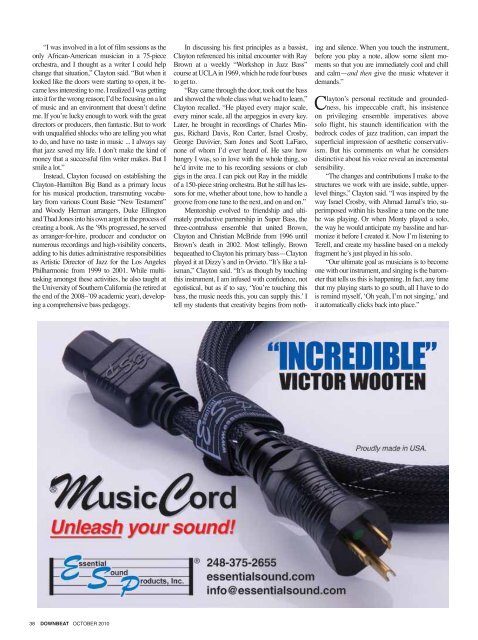Download - Downbeat
Download - Downbeat
Download - Downbeat
Create successful ePaper yourself
Turn your PDF publications into a flip-book with our unique Google optimized e-Paper software.
“I was involved in a lot of film sessions as the<br />
only African-American musician in a 75-piece<br />
orchestra, and I thought as a writer I could help<br />
change that situation,” Clayton said. “But when it<br />
looked like the doors were starting to open, it became<br />
less interesting to me. I realized I was getting<br />
into it for the wrong reason; I’d be focusing on a lot<br />
of music and an environment that doesn’t define<br />
me. If you’re lucky enough to work with the great<br />
directors or producers, then fantastic. But to work<br />
with unqualified shlocks who are telling you what<br />
to do, and have no taste in music ... I always say<br />
that jazz saved my life. I don’t make the kind of<br />
money that a successful film writer makes. But I<br />
smile a lot.”<br />
Instead, Clayton focused on establishing the<br />
Clayton–Hamilton Big Band as a primary locus<br />
for his musical production, transmuting vocabulary<br />
from various Count Basie “New Testament”<br />
and Woody Herman arrangers, Duke Ellington<br />
and Thad Jones into his own argot in the process of<br />
creating a book. As the ’90s progressed, he served<br />
as arranger-for-hire, producer and conductor on<br />
numerous recordings and high-visibility concerts,<br />
adding to his duties administrative responsibilities<br />
as Artistic Director of Jazz for the Los Angeles<br />
Philharmonic from 1999 to 2001. While multitasking<br />
amongst these activities, he also taught at<br />
the University of Southern California (he retired at<br />
the end of the 2008–’09 academic year), developing<br />
a comprehensive bass pedagogy.<br />
38 DOWNBEAT OCTOBER 2010<br />
In discussing his first principles as a bassist,<br />
Clayton referenced his initial encounter with Ray<br />
Brown at a weekly “Workshop in Jazz Bass”<br />
course at UCLA in 1969, which he rode four buses<br />
to get to.<br />
“Ray came through the door, took out the bass<br />
and showed the whole class what we had to learn,”<br />
Clayton recalled. “He played every major scale,<br />
every minor scale, all the arpeggios in every key.<br />
Later, he brought in recordings of Charles Mingus,<br />
Richard Davis, Ron Carter, Israel Crosby,<br />
George Duvivier, Sam Jones and Scott LaFaro,<br />
none of whom I’d ever heard of. He saw how<br />
hungry I was, so in love with the whole thing, so<br />
he’d invite me to his recording sessions or club<br />
gigs in the area. I can pick out Ray in the middle<br />
of a 150-piece string orchestra. But he still has lessons<br />
for me, whether about tone, how to handle a<br />
groove from one tune to the next, and on and on.”<br />
Mentorship evolved to friendship and ultimately<br />
productive partnership in Super Bass, the<br />
three-contrabass ensemble that united Brown,<br />
Clayton and Christian McBride from 1996 until<br />
Brown’s death in 2002. Most tellingly, Brown<br />
bequeathed to Clayton his primary bass—Clayton<br />
played it at Dizzy’s and in Orvieto. “It’s like a talisman,”<br />
Clayton said. “It’s as though by touching<br />
this instrument, I am infused with confidence, not<br />
egotistical, but as if to say, ‘You’re touching this<br />
bass, the music needs this, you can supply this.’ I<br />
tell my students that creativity begins from noth-<br />
ing and silence. When you touch the instrument,<br />
before you play a note, allow some silent moments<br />
so that you are immediately cool and chill<br />
and calm—and then give the music whatever it<br />
demands.”<br />
Clayton’s personal rectitude and groundedness,<br />
his impeccable craft, his insistence<br />
on privileging ensemble imperatives above<br />
solo flight, his staunch identification with the<br />
bedrock codes of jazz tradition, can impart the<br />
superficial impression of aesthetic conservativism.<br />
But his comments on what he considers<br />
distinctive about his voice reveal an incremental<br />
sensibility.<br />
“The changes and contributions I make to the<br />
structures we work with are inside, subtle, upperlevel<br />
things,” Clayton said. “I was inspired by the<br />
way Israel Crosby, with Ahmad Jamal’s trio, superimposed<br />
within his bassline a tune on the tune<br />
he was playing. Or when Monty played a solo,<br />
the way he would anticipate my bassline and harmonize<br />
it before I created it. Now I’m listening to<br />
Terell, and create my bassline based on a melody<br />
fragment he’s just played in his solo.<br />
“Our ultimate goal as musicians is to become<br />
one with our instrument, and singing is the barometer<br />
that tells us this is happening. In fact, any time<br />
that my playing starts to go south, all I have to do<br />
is remind myself, ‘Oh yeah, I’m not singing,’ and<br />
it automatically clicks back into place.”

















